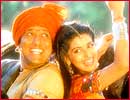Countrywaale: very good, very good!
Deepa Gahlot
Our filmmakers continue to be fascinated by the idea of a
village as an idyll, a paradise where people are innocent and simple, where
women in bright clothes sing on the way to the well with pitchers on their
heads, where farmers sing joyously while harvesting crops, where everybody
dances together and stays happy.

Cities are dens of vice, where na´ve villagers get corrupted. Everybody
smokes, drinks, parties endlessly and turns up his/her nose at rustic folk
who can't eat with a fork. The villager than takes a dafli and sings a song about the heart of
real India, that shames the wicked urbanite.
Strangely, the villager never encounters the honest,
hard-working lower and middle class urbanite, he is always plonked right
into the midst of a depraved upper class milieu.
Watching Mahesh Manjrekar's latest Govinda starrer, Jis Desh Mein Ganga Rehta Hai with a mix
of irritation and amusement, one can't but wonder which insulated world our
filmmakers live in.
They might not ever step out of their air-conditioned flats and cars. But
don't they even read the papers? Don't they know the age of rustic
innocence is over? Was over long ago?

Don't they know TV and cinema have reached all but the remotest tribal
village, where people are so hungry, illiterate and sick, that they can't
possibly do the Govinda-style bouncy dance numbers? Can
there be a villager today who doesn't know how to wear a pair of trousers
and has never seen a slice of bread?
So commercial filmmakers don't want to show the
bitter reality that parallel filmmakers portray with such insight. They sell
dreams, but the audience they are selling these dreams to is not buying them
any more.
They (audience) know
better, because they are the villagers who have left behind their deadend
existence and come to a live in a city slum that affords them the time and
money to see films that try to show them an
idealised view of their own lives.
They are the cabbies, paanwallahs, waiters, watchmen, hawkers who never lived
Govinda's Jis Desh Mein
life. Never in their wildest imagination did a rich mini-skirted city girl
fall in love
with them, or is ever likely to.
 In that sense, Hansal Mehta's Dil Pe Mat Le Yaar -- also unsuccessful
at the BO -- was a slightly more realistic picture of city life as seen from
the point of view of a Jaunpur bhaiya (Manoj Bajpai), working as a garage mechanic, and
living in a filthy room with a dozen others.
In that sense, Hansal Mehta's Dil Pe Mat Le Yaar -- also unsuccessful
at the BO -- was a slightly more realistic picture of city life as seen from
the point of view of a Jaunpur bhaiya (Manoj Bajpai), working as a garage mechanic, and
living in a filthy room with a dozen others.
His Jaunpur -- recreated for the audience through his letters home -- is
also tinged with nostalgia and probably not as bucolic as he would like to
preserve in his memory. He falls in love with a journalist (Tabu). But but
unlike mainstream heroines from Nanda (Jab Jab Phool Khile) to Karisma Kapoor (Raja Hindustani), she does not want to
live with him in poverty and squalor. She throws him out.
Maybe this was much too realistic for all the Jaunpur cabbies and paanwallahs who rejected this
film, too.
In another recent film, Aaghaaz, Govind (Sunil Shetty) comes from a Punjab
village with his values intact and is appalled at the cowardice and
heartlessness of his city neighbours. He fights gangsters on behalf of all
of them and teaches them to be brave.

This film also bombed at the BO, perhaps because audiences are now too
dazzled by the gloss of the Yash Chopra-style opulent romances, where no
unpleasant reality intrudes at any level. Even the villages in these films
-- Kunwara and Dhaai Akshar Prem Ke to take
recent examples -- are in paradise
islands away from all civilisation, where the glorious Indian joint family
is preserved in formaldehyde. (Anyway, these films flopped too -- what DO
audiences want?)
Govinda's Ganga has only Dada Kondke's idiotic
villager as precedent, and in no way represents the immigrant experience,
that so many filmmakers have dealt with in a variety of ways from the
poignancy of Muzaffar Ali's Gaman, the grittiness of Sai Paranjpye's Disha to the unabashed commercial
 melodrama of Gaon Hamara Shehar
Tumhara and Rampur Ka
Laxman.
melodrama of Gaon Hamara Shehar
Tumhara and Rampur Ka
Laxman.
But Ramsaran of Dil Pe
is a descendent of the Raju of Shri
420 (Raj Kapoor loved playing the rural innocent in the urban
wilderness) and Raju Ban Gaya
Gentleman, Vijay of Agneepath and even the eponymous Satya.
The two Rajus survived the city with traces of their village simplicity. And
they had the love of good women to redeem them. The other two were swallowed
up whole and spat out as monsters. Hardly anyone in mainstream cinema wants
to tackle the reality of village as well as city life, seen in the
contemporary context -- with all its contradictions and contrasts.
 One would, perhaps, like to see a film about an
honest, unspoiled city dweller, lost in the badlands of rural Bihar, where
he is very likely to have his throat slit for his shoes!
One would, perhaps, like to see a film about an
honest, unspoiled city dweller, lost in the badlands of rural Bihar, where
he is very likely to have his throat slit for his shoes!
But who's going to break the mould of stereotype?
Email Deepa Gahlot